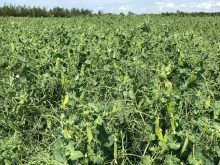A couple of months ago, I penned the article, “Profit is not a four-letter word,” after which I intended to immediately delve into agricultural companies’ investment merits. However, I was diverted to oil company investments after a quote from the director general of the United Nations so perfectly illustrated my points in the “profits” article. I will now explore the ag companies project.
If ag companies make too much money on the backs of hard-working farmers, they would make great investments, wouldn’t they? Would they be good TFSA or RRSP investments? Could you benefit from their successes?
By way of review, the following are the definitions in the chart below:
Read Also

Gentle treatments for pain in the neck
Heading toward year-end, people unknowingly tense up against the cold and busyness, causing neck pain that can often be treated with appropriate support and gentle mobility, athletic therapist Kathlyn Hossack says.
- ROE (return on equity) is the profit/equity or book value of the company.
- ROA (return on assets) are the profit/total assets employed by the company, which is debt plus equity.
- CF/A (cash flow/assets) is the operating cash flow derived from the assets employed.
- P/E (price earnings ratio) is the price of the stock divided by earnings per share.
- P/CF (price/cash flow) is the price of the stock divided by the cash flow per share.
- FCF/Sh (free cash flow per share) is the operating cash flow minus capital investments, or free cash flow. That’s what the owner really gets as “take-home pay.”

ROE, ROA and CF/A are all measures of company profitability and are calculated as percentages, although the per cent sign is rarely used. P/E and P/CF are how much you pay for that profitability, or dollars paid per dollar of annual earnings or cash flow.
The chart includes trailing 12 months and the average annual numbers for the last decade. I used the trailing 12-month metric as an approximation for 2022 in the decade-long averages — a slight imperfection but it doesn’t affect the overall picture to a great degree.
I looked at four categories of companies that service the ag industry: banks, fertilizer, equipment, and seed and crop protection. I used their ticker symbols in the chart. Let’s delve into each sector.
More with Herman VanGenderen: Are energy companies displaying “grotesque greed”?
Banks
While agriculture is a small part of their overall business, banks are a big part of a farmer’s business and as such they merit review. Cash flow is not an effective measure for banks. ROA is low for banks compared with other industries but is still a good comparison between banks, with ROE being the best profitability metric to evaluate. There isn’t much difference between the banks as all have acceptable ROEs, both currently and over the past decade. Royal Bank (RY) has the best ROE and ROA, so it comes as no surprise it also had the best stock price appreciation, with Toronto Dominion (TD) a close second.
Bank stocks have declined 20 to 30 per cent this year due to recession fears and the popping of the housing bubble, making the current P/E attractive. Overall, while not spectacular, Canadian banks are solid long-term investments with excellent consistency.
Fertilizer
The past 12 months have been highly profitable for this industry. If this was the norm, I would be all in as an investor. However, review of the 10-year numbers paints an entirely different picture. Fertilizer earnings and cash flows fluctuate from year to year. From a decade-long perspective, they are not attractive. Once again, the company with the best profitability metrics, CF Industries, also has the best stock price appreciation. However, the entire gain has been over the past year. The industry is analogous to my definition of baseball — long periods of boredom briefly interrupted with momentary excitement.
Equipment
The examples in this category show vast differences in financial performance. The runaway leader has been Deere while its most direct competitor, CNH Industries, hasn’t gone anywhere in a decade. Agco was in the middle, while Canadian Ag Growth International was dismal. The vast majority of Agco and Deere’s price appreciation came in 2020-21.
Seed and crop protection
This category underwent significant reorganization three to four years ago, with the China National Chemical Corporation’s purchase of Syngenta, Bayer’s purchase of Monsanto, BASF’s purchase of InVigor, as well as the Dow/DuPont merger and subsequent spin-off of Corteva, with FMC picking up most of DuPont’s legacy crop protection business.
As a result, there are only two large North American publicly traded corporations left in the space: Corteva, with both seed and chemicals, and FMC. Both have performed well from a stock price appreciation standpoint, although Corteva (CTVA) only has three years of history. I have a slight bias having had a 40-year relationship as an employee and sales rep for Pioneer Hi-Bred, a big part of Corteva.
Bayer and BASF are large chemical conglomerates based out of Germany. You can buy shares on the “over the counter” market but I stick to openly traded companies. Their share price performance has been abysmal. Over the past decade, Bayer has gone from $21.79 to $12.63 and BASF declined from $20.65 to $11.50. Ouch!
I don’t like what I see
I like consistent long-term growth. This is my first in-depth look at the entire ag supply sector from an investor perspective, and I don’t like what I see except for the Canadian bank sector. I own all five of the banks mentioned in different accounts. TD and RY have been the best, but Bank of Nova Scotia (BNS) and Canadian Imperial Bank of Commerce (CM) look like the best value today. I can’t recall ever selling a Canadian bank stock and usually try to buy more after a sell-off, like now. I tend to add to the one with the lowest current valuation.
I also own a small amount of Nutrien Ltd. and Corteva. After completing this exercise, I am appreciative of not having ventured too far into the ag supply space. There is an absence of consistent profitable growth with generally low returns except during commodity price spikes.
Farmers have a lot riding on agriculture. Investing in public companies that ride the same wave as your farm may not be the best approach. When I began this exercise, it was not the conclusion I expected. I thought there would be some gems, allowing you to participate in your suppliers’ successes. If you still choose to invest in ag supply companies, pick those with the best long-term ROE, ROA and CF/A currently trading with decent P/E and P/CF ratios.
















